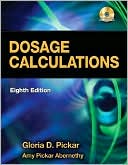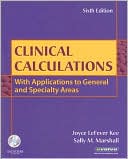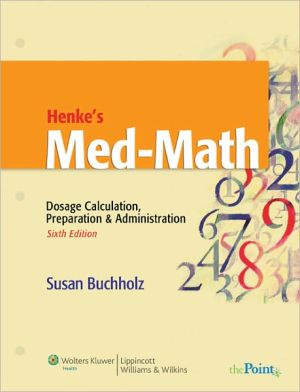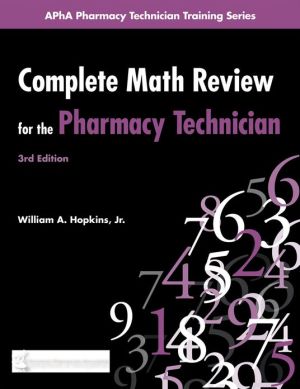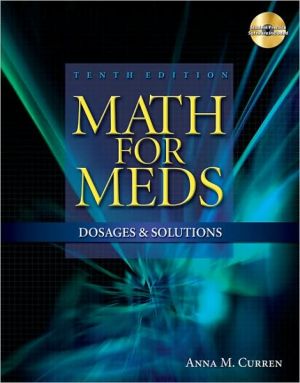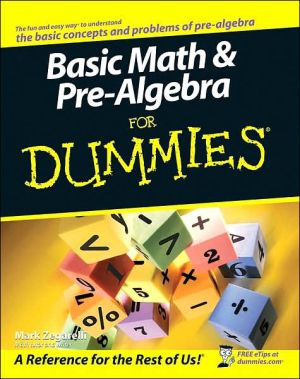Speed Mathematics: Secret Skills for Quick Calculation
Using this book will improve your understanding of math and have you performing like a genius!\ People who excel at mathematics use better strategies than the rest of us; they are not necessarily more intelligent.\ Speed Mathematics teaches simple methods that will enable you to make lightning calculations in your head-including multiplication, division, addition, and subtraction, as well as working with fractions, squaring numbers, and extracting square and cube roots. Here's just one...
Search in google:
Using this book will improve your understanding of math and have you performing like a genius! People who excel at mathematics use better strategies than the rest of us; they are not necessarily more intelligent. Speed Mathematics teaches simple methods that will enable you to make lightning calculations in your head-including multiplication, division, addition, and subtraction, as well as working with fractions, squaring numbers, and extracting square and cube roots. Here's just one example of this revolutionary approach to basic mathematics: 96 x 97 = Subtract each number from 100. 96 x 97 = 4 3 Subtract diagonally. Either 96--3 or 97-- 4. The result is the first part of the answer. 96 x 97 = 93 4 3 Multiply the numbers in the circles. 4 x 3 = 12. This is the second part of the answer. 96 x 97 = 9312 4 3 It's that easy!
Speed Mathematics\ Secrets Skills for Quick Calculation \ \ By Bill Handley \ John Wiley & Sons\ ISBN: 0-471-46731-6 \ \ \ Chapter One\ Multiplication: Part One \ How well do you know your basic multiplication tables?\ How would you like to master your tables up to the 10 times tables in less than 10 minutes? And your tables up to the 20 times tables in less than half an hour? You can, using the methods I explain in this book. I only assume you know the 2 times tables reasonably well, and that you can add and subtract simple numbers.\ Multiplying Numbers up to 10\ We will begin by learning how to multiply numbers up to 10 × 10. This is how it works:\ We'll take 7 × 8 as an example.\ Write 7 × 8 = down on a piece of paper and draw a circle below each number to be multiplied.\ 7 × 8 =\ Now go to the first number to be multiplied, 7. How many more do you need to make 10? The answer is 3. Write 3 in the circle below the 7. Now go to the 8. What do we write in the circle below the 8? How many more to make 10? The answer is 2. Write 2 in the circle below the 8.\ Your work should look like this:\ 7 × 8 =\ 3 2\ Now subtract diagonally. Take either one of the circled numbers (3 or 2) away from the number, not directly above, but diagonally above, or crossways. In other words, you either take 3 from 8 or 2 from 7. You only subtract one time, so choose the subtraction you find easier. Either way, the answer is thesame, 5. This is the first digit of your answer. 8 - 3 = 5 or 7 - 2 = 5\ Now multiply the numbers in the circles. Three times 2 is 6. This is the last digit of your answer. The answer is 56. This is how the completed problem looks.\ 7 × 8 = 56\ 3 2\ If you know the 2 times tables reasonably well, you can easily master the tables up to the 10 times table, and beyond. Let's try another example, 8 × 9.\ 8 × 9 =\ 2 1\ How many more to make 10? The answer is 2 and 1. We write 2 and 1 in the circles below the numbers. What do we do now? We subtract diagonally.\ 8 - 1 = 7 or 9 - 2 = 7\ Seven is the first digit of your answer. Write it down. Now multiply the two circled numbers.\ 2 × 1 = 2\ Two is the last digit of the answer. The answer is 72.\ Isn't that easy? Here are some problems to try by yourself. Instead of writing the answers in the book, you may prefer to write the answers on a piece of paper or in a notebook so that you can do the problems again if you wish.\ a) 9 × 9 = e) 8 × 9 =\ b) 8 × 8 = f) 9 × 6 =\ c) 7 × 7 = g) 5 × 9 =\ d) 7 × 9 = h) 8 × 7 =\ Do all of the problems, even if you know your tables well. This is the basic strategy we will use for almost all of our multiplication.\ How did you do? The answers are:\ a) 81 b) 64 c) 49 d) 63\ e) 72 f) 54 g) 45 h) 56\ Isn't this the easiest way to learn your tables?\ To Learn or Not to Learn Tables?\ Now that you have mastered this method, does it mean you don't have to learn your tables?\ The answer is yes and no.\ No, you don't have to memorize your tables because you can now, with a little practice, calculate your tables instantly. If you already know your tables then learning this method is a bonus.\ The good news is that, if you don't know them, you will learn your tables in record time. After you have calculated 7 × 8 = 56 a dozen or more times you will find you remember the answer. In other words, you have learned your tables. Again, this is the easiest method I know to learn your tables, and the most pleasant. And you don't have to worry if you haven't learned them all by heart-you will calculate the answers so quickly that everyone will believe you know them anyway.\ Multiplying Numbers Greater Than 10\ Does this method work for multiplying large numbers?\ It certainly does. Let's try an example:\ 96 × 97 =\ What do we take these numbers up to? How many more to make what? One hundred. So we write 4 under 96 and 3 under 97.\ 96 × 97 =\ 4 3\ What do we do now? We take away diagonally. 96 minus 3 or 97 minus 4 equals 93. This is the first part of your answer. What do we do next? Multiply the numbers in the circles. Four times 3 equals 12. This is the last part of the answer. The full answer is 9,312.\ 96 × 97 = 9,312\ 4 3\ Which method is easier, this method or the method you learned in school? This method, definitely.\ Remember my first law of mathematics:\ The easier the method you use, the faster you do the problem and the less likely you are to make a mistake.\ Now, here are some more problems to do by yourself.\ a) 96 × 96 = e) 98 × 94 =\ b) 97 × 95 = f) 97 × 94 =\ c) 95 × 95 = g) 98 × 92 =\ d) 98 × 95 = h) 97 × 93 =\ The answers are:\ a) 9,216 b) 9,215 c) 9,025 d) 9,310\ e) 9,212 f) 9,118 g) 9,016 h) 9,021\ Did you get them all right? If you made a mistake, go back, find where you went wrong and do it again. Because the method is so different from conventional ways of learning tables, it is not uncommon to make mistakes in the beginning.\ Racing a Calculator\ I have been interviewed on television news programs and documentaries, where they often ask me to compete with a calculator. It usually goes like this. They have a hand holding a calculator in front of the camera and me in the background. Someone from off-screen will call out a problem like 96 times 97. As they call out 96, I immediately take it from 100 and get 4. As they call the second number, 97, I take 4 from it and get an answer of 93. I don't say 93, I say nine thousand, three hundred and ... I say this with a slow Australian drawl. While I am saying nine thousand, three hundred, I am calculating in my mind, 4 times 3 is 12.\ So, with hardly a pause I call, "Nine thousand, three hundred and ... twelve." Although I don't call myself a "lightning calculator"-many of my students can beat me-I still have no problem calling out the answer before anyone can get the answer on their calculator.\ Now do the last exercise again, but this time, do all of the calculations in your head. You will find it is much easier than you imagine. I tell students, you need to do three or four calculations in your head before it really becomes easy; you will find the next time is so much easier than the first. So, try it five times before you give up and say it is too difficult.\ Are you excited about what you are doing? Your brain hasn't grown suddenly; you are using it more effectively by using better and easier methods for your calculations.\ (Continues...)\ \ \ \ \ Excerpted from Speed Mathematics by Bill Handley Excerpted by permission.\ All rights reserved. No part of this excerpt may be reproduced or reprinted without permission in writing from the publisher.\ Excerpts are provided by Dial-A-Book Inc. solely for the personal use of visitors to this web site. \ \
PrefaceIntroduction1Multiplication: Part One12Using a Reference Number63Multiplying Numbers Above and Below the Reference Number144Checking Answers: Part One185Multiplication: Part Two256Multiplying Decimals417Multiplying Using Two Reference Numbers478Addition599Subtraction6610Squaring Numbers7511Short Division8712Long Division by Factors9213Standard Long Division9814Direct Division10415Division by Addition11516Checking Answers: Part Two13317Estimating Square Roots13918Calculating Square Roots14919Fun Shortcuts16020Adding and Subtracting Fractions17821Multiplying and Dividing Fractions18422Direct Multiplication19023Estimating Answers19724Using What You Have Learned201Afterword209App. AFrequently Asked Questions211App. BEstimating Cube Roots217App. CChecks for Divisibility224App. DWhy Our Methods Work233App. ECasting Out Nines - Why It Works239App. FSquaring Feet and Inches241App. GHow Do You Get Students to Enjoy Mathematics?244App. H: Solving Problems248Glossary250Index253


